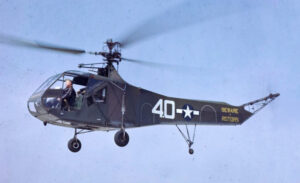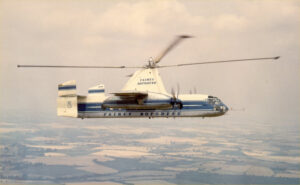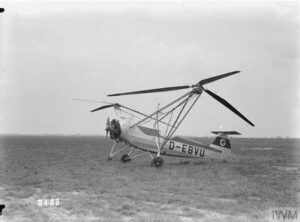
 In 1942, the Sikorsky R-4 became the first helicopter to reach full-scale production. The creators had high hopes for the helicopter. They wanted it to become a mode of mass transit. Unfortunately, it just never caught on as a form of mass transit, not even when the Fairey Rotodyne came out. Nevertheless, it did receive one brave British attempt at that lofty goal.
In 1942, the Sikorsky R-4 became the first helicopter to reach full-scale production. The creators had high hopes for the helicopter. They wanted it to become a mode of mass transit. Unfortunately, it just never caught on as a form of mass transit, not even when the Fairey Rotodyne came out. Nevertheless, it did receive one brave British attempt at that lofty goal.
The Fairey Rotne was an unusual sight, seemingly blurring the boundaries of aviation. It looked like a half plane and half helicopter. Developed during the 1950s and early 1960s, in the early days of the helicopter, the United Kingdom hoped it would become a form of everyday transport. Of course, the intrigue of this helicopter is the fact that it can take off vertically using rotors with jets at their tips, but it was also powered forward by turboprops on the wing. The plan was for it to allow quick travel between cities and towns in the UK and around Europe. That dream was dashed when the project died an early death. The main problems were a lack of funding and concerns over noise.
Some people thought it was because the idea was “ahead of its time.” The idea just never too off, and orders were “hard to come by and interest faded.” I suppose that people just have a hard time accepting something new. Aviation can be even harder to accept new things with. I don’t know what kind of expense such “ride” would have been, but if it is anything like some of the little “hopper flights” from city to city, they are anything but cheap. That makes the use of a Fairey Rotodyne Hopper impractical.
The British project began in 1953 when the state-owned British European (BEA) commissioned the aviation firm Fairey to design a helicopter-type aircraft for commercial passenger. Henrich Focke, a German had developed the Focke-Wulf FW61, 17 years earlier. It was regarded as the world’s first practical helicopter, but even that one didn’t take off as a mass transport vehicle. BEA, which commenced small-scale services in 1950, sought an aircraft capable of taking off easily in urban areas and large enough to transport over 50 people swiftly to another location. The aim was to land in confined inner-city spaces and capitalize on the expanding European business travel market. Fairey introduced the Rotodyne, a composite helicopter that combines features of both an airplane and a helicopter. The Ministry of Supply supported the project by providing funding for its technical development. On June 16, 1959, it embarked on its inaugural international flight, traveling from Heathrow to Paris, with stops in Dover and Brussels. The journey to Brussels took one hour and 36 minutes, the leg from Brussels to Paris took 58 minutes, significantly faster than the alternative modes of transport such as ferry and train, or plane and car.
They gave it their best effort, but in the end, the project would simply not ever really take off. Some were shocked, saying, “This service will fly families out (and in) for holidays, take businessmen on business trips, 
 and increase the self-sufficiency of every busy provincial centre by providing the swift, direct communication nowadays so essential to the development of trade. Ever since helicopters were invented, there has been talk of rotary-wing services between city centres.” Nevertheless, despite the obvious thoughts by many that this would be a good thing, it just never got a good foothold, and eventually it failed.
and increase the self-sufficiency of every busy provincial centre by providing the swift, direct communication nowadays so essential to the development of trade. Ever since helicopters were invented, there has been talk of rotary-wing services between city centres.” Nevertheless, despite the obvious thoughts by many that this would be a good thing, it just never got a good foothold, and eventually it failed.


Leave a Reply